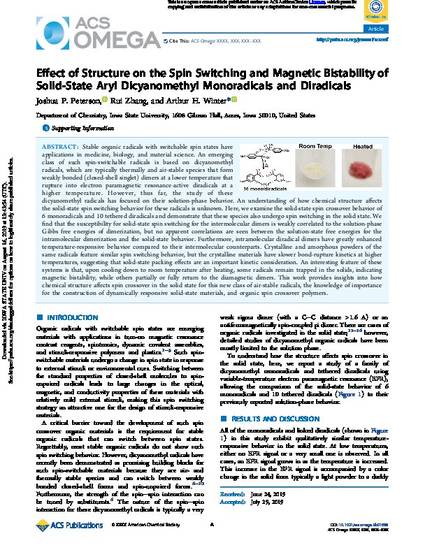
Stable organic radicals with switchable spin states have applications in medicine, biology, and material science. An emerging class of such spin-switchable radicals is based on dicyanomethyl radicals, which are typically thermally and air-stable species that form weakly bonded (closed-shell singlet) dimers at a lower temperature that rupture into electron paramagnetic resonance-active diradicals at a higher temperature. However, thus far, the study of these dicyanomethyl radicals has focused on their solution-phase behavior. An understanding of how chemical structure affects the solid-state spin switching behavior for these radicals is unknown. Here, we examine the solid-state spin crossover behavior of 6 monoradicals and 10 tethered diradicals and demonstrate that these species also undergo spin switching in the solid state. We find that the susceptibility for solid-state spin switching for the intermolecular dimers is weakly correlated to the solution-phase Gibbs free energies of dimerization, but no apparent correlations are seen between the solution-state free energies for the intramolecular dimerization and the solid-state behavior. Furthermore, intramolecular diradical dimers have greatly enhanced temperature-responsive behavior compared to their intermolecular counterparts. Crystalline and amorphous powders of the same radicals feature similar spin switching behavior, but the crystalline materials have slower bond-rupture kinetics at higher temperatures, suggesting that solid-state packing effects are an important kinetic consideration. An interesting feature of these systems is that, upon cooling down to room temperature after heating, some radicals remain trapped in the solids, indicating magnetic bistability, while others partially or fully return to the diamagnetic dimers. This work provides insights into how chemical structure affects spin crossover in the solid state for this new class of air-stable radicals, the knowledge of importance for the construction of dynamically responsive solid-state materials, and organic spin crossover polymers.
Available at: http://works.bepress.com/arthur_winter/30/

This document is the Accepted Manuscript version of a Published Work that will appear in final form in ACS Omega, copyright © American Chemical Society after peer review and technical editing by the publisher. To access the final edited and published work see 10.1021/acsomega.9b01658. Posted with permission.